Two Cultures, Two Homes
Out of the things I expected upon going to my hometown in the Philippines, to be dragged to the market by my family to see a man chop a cow’s tongue, or dila, out of its head, was not one of them.
Here I was, back in my hometown, which I visited around every four years. After three connected flights, one of which was over 12 hours of cramped legs and shuffling through the aisle, and an hour-long drive that curved through the lush mountains, we had made our way to Antique, the province of which I came from.
My parents and I had left when I was just 2, making for ourselves a life in America. We had come back two times previous to this trip, with Skype calls and Facebook messages filling in the space in between when we were not with our family.
As I had learned during my 22 days in my hometown, the markets in a Philippine province, such as Antique, brought everyone together. People came down from the mountains surrounding the area with goods, and came to buy what they needed.
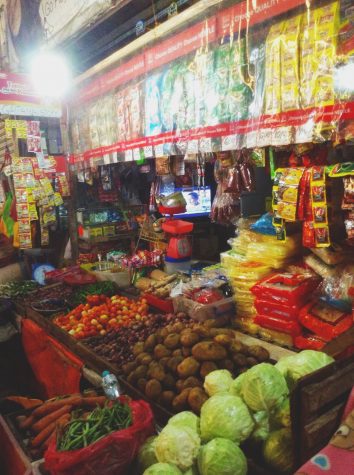
Photo One: Fresh fruits and vegetables, along with soup mix, are sold as the Philippine News, TV Patrol, plays in the background. The stand is quiet towards the end of the day as people begin to stream out. Used with permission of Argee Velardo.
One thing was for sure, it wasn’t like Walmart.
As I had driven there that morning, I could remember gazing at all the motorcycles and tricycles (a Philippine vehicle where a sidecar is attached to a motorcycle and the driver is paid for a ride) that dominated the street, replacing the cars I was used to in America.
One thing I noticed every time we went around the Philippines was the abundance of butterflies. In America, if you noticed one, it was interesting, but in the Philippines, they kind of fluttered around everywhere, even when we were on a boat. It made me realize just how rural our area was.
When we entered the market, I could hear the voices of people, discussing orders for meat or vegetables. I could see sections of stalls, kind of the way you had sections of food in grocery stores. The air smelled different wherever you went. Here, in the fish section, came the salty smell of the sea. Here, in the fruits, came the sweet smell of mangoes and santol. The air smelled like home, like the Philippines.
Here, you could buy meat, and here there are vegetables. Here, you could get woven goods and over there, puto, Filipino steamed rice cakes served with dinuguan or pancit.
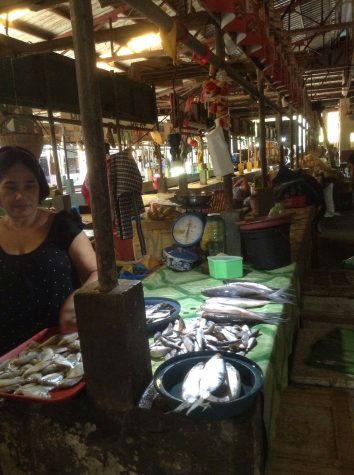
Photo Two: In the Philippines, if your fish is still flipping, you know it is fresh. This woman sells fresh fish at the market in the afternoon, waiting for the last-minute customers. Used with permission of Argee Velardo.
In fact, my Tito, or Uncle, had pulled me over to buy puto as my Dad went to buy vegetables.
“Tag pira?” he asked the saleslady, asking how much they were in the language I spoke at home, kinaray-a.
“30 pesos,” one of them responded, fanning themselves with one of those fans I always see people use in the balmy Philippine weather.
“Pwede 20 pesos?” my Tito had responded in the Philippine tradition of bargaining prices. It was a skill I had never learned in America, but one my parents had grown up with.
On our way out of the market, we passed by a fruits stand where a lady was selling fruit, from the ones we knew, like bananas, to the ones I had to explain to my friends when I got back, like santol (or cottonfruit).
“Bata kaw ni Yoyoy?” she interrogated me, a question I had commonly been asked in Antique. Here, I was either the daughter of Yoyoy or the daughter of Karen. It seemed my parents knew everybody in the town.
“Yes, I’m visiting for the summer,” I would respond, beginning to explain how I could understand kinaray-a, but not speak it, as they marveled over how tall I had grown.
Before we left, we bought one last thing: a woven hammock to put in the backyard. My cousin and I had marveled at it at first, before discovering it to be both scratchy and wobbly. Still, there was no better feeling than to in the backyard with a book, lying in the cool shadow of the tree that held a swing that had been there since our first visit. There were chickens and roosters roaming the grounds, bringing with them clucks and crows as they pecked at fallen fruit.
Occasionally, one of the dogs may muster up the strength to approach, before being frightened away by any sudden movements. Many balmy days at the start were spent there, swinging in my Lola’s backyard.
Sometime later, we had returned to our car. Car rides were where I noticed the most differences between my old country and my new country.
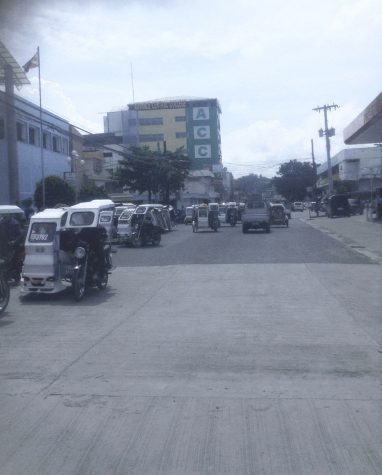
Photo Three: The streets of the Philippines are clogged with Filipino tricycles. Tricycles are a common mode of transportation similar to a taxi where you pay for a ride. They are used for tasks such as going to the mall or even going to school. There are much less cars than you would find in America. Used with permission of Argee Velardo.
In the mornings, I would see the students going to school as they had started in June. They all wore uniforms, either the long plaid skirt and white shirt for girls or the white shirt and black pants for boys. It made me feel out of place when I was the only one out of uniform at the mall.
During my first visit home to the Philippines, my Lola, or grandma, had the grand idea of enrolling me in a Filipino school.
Good Shepherd Academy they had called it when I arrived. English Shepherd Academy they had joked when I left.
The school itself was the size of about one of the wings at my school in America. There was one class per grade, and no cafeteria. During lunch, kids either ate their previously-packed lunches or left to eat at home or at a restaurant.
Needless to say, homework wasn’t the only thing I was confused about.
Still, I loved it anyway. I loved to learn about the country I had left behind and to meet new people my age, no matter how they accepted me.
One of my favorite car rides to take was the one to Hamtic, where my great-grandmother lived. On the way there, you had sea and surf on your right. At one point, you could see a harbor clogged by boats. To your right, you had the mountains and rice fields on your left. Sun filtered past the mountains as we drove the rocky Filipino roads to Hamtic.
My Lola Violeta had a tiangge, or a small store. There, she sold everything from rice to cigarettes. My favorite thing, though was the batchoy she sold there.
It was a steaming, aromatic bowl of soup filled with meat, noodles, and crushed pork cracklings. It had been founded near my home province, but that was quickly forgotten as I dove in.
Now, as we drove by, I watched them all and wondered how my life would be if we hadn’t immigrated to America. We would have been closer to family, to nature, to what I still call home. Yet we wouldn’t have had the same opportunities that were given to me in America.
By going home, I had learned both the cultures of the two places I called home and the differences between them. I learned to respect and understand the beauty of both worlds, but a part of me will always be with my roots in the Philippines. I have learned to love two cultures and two homes.
Your donation will help support The Lambert Post, Lambert High Schools student-run newspaper! Your contribution will allow us to purchase equipment and cover website hosting costs.



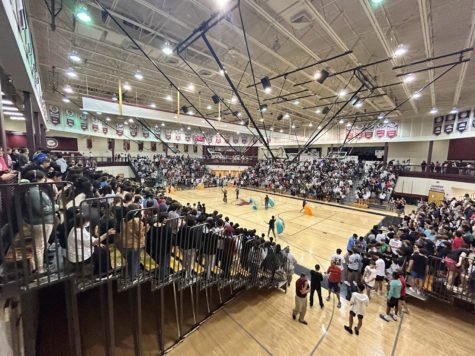




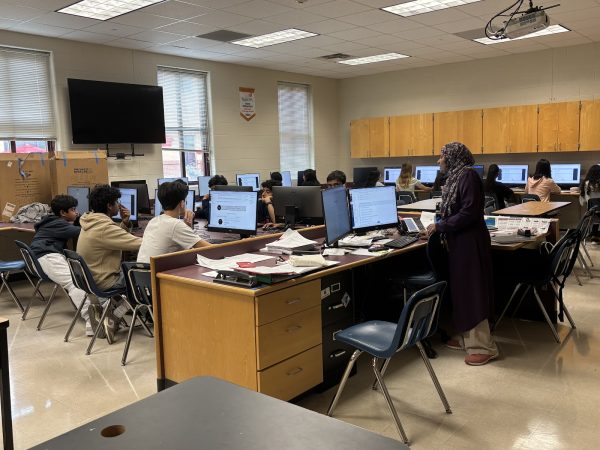
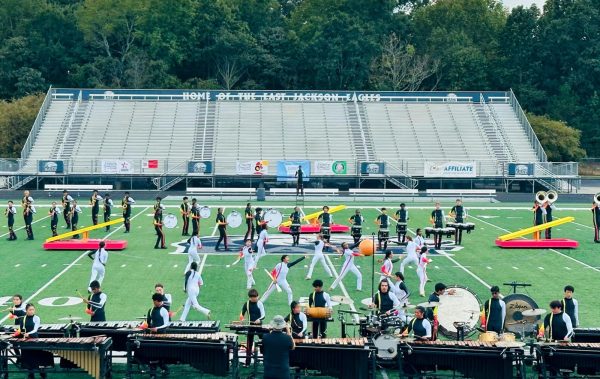
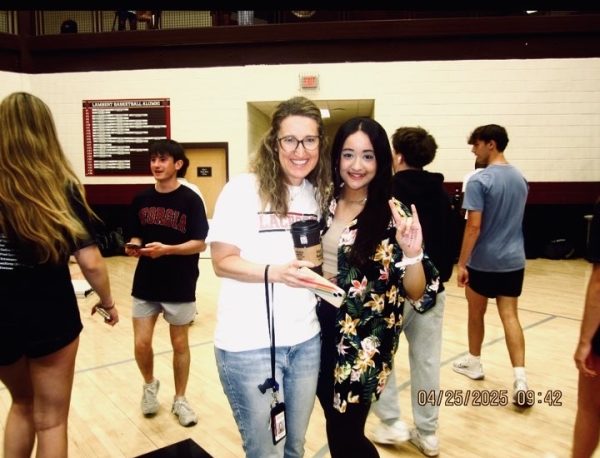

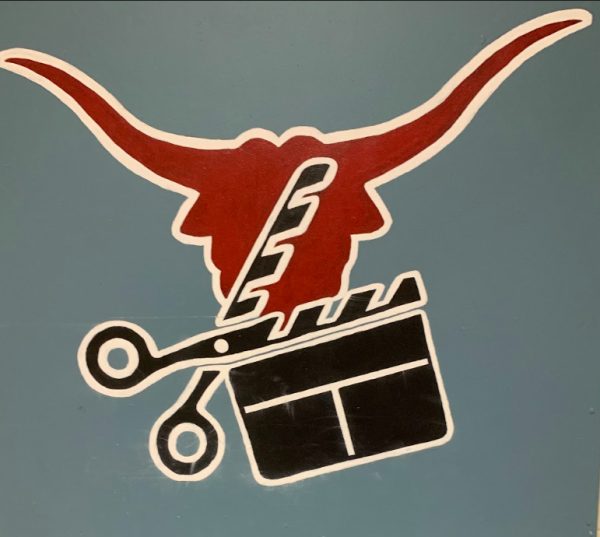
Dimple Juala • Oct 3, 2016 at 10:34 pm
So proud of you Allie! Always remember where you came from so you will appreciate how far you have come. Wear the culture of your roots like a badge because it makes you who you are – unique, blessed and privileged to know two worlds you can both learn from as you go through life.